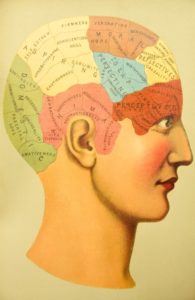MindCheck is the Weekly Wednesday Kids Mental Health series with Dr. Ray Pataracchia N.D. MindCheck provides in depth information on the orthomolecular approach to coping with mood, behavior and psychotic disorders. The MindCheck Health Series is endorsed by the Mindful Network – ‘A Better Future for Children’s Mental Health’.
As is depicted in this illustration, the brain is responsible for a diversity of mental faculties. Orthomolecular nutrition provides a means for treating the diversity of psychotic symptoms that we see in schizophrenia.
PANSS Assessment and Orthomolecular Treatment
The goal in orthomolecular treatment of schizophrenia is to treat psychosis early and intervene with the aim of reducing severity.
Here in this blog I describe the type of symptoms that are assessed when using the Positive and Negative Syndrome Scale (PANSS), the gold standard tool for assessing symptom severity in schizophrenia.
Our standard of care service uses HOD testing to assess symptom severity. The NMRC offers PANSS assessment as a service but HOD testing is easier to use clinically and quite helpful in assessing symptom severity in schizophrenia and also, mood and behavior disorders. The HOD test factors in time distortions as a component of psychotic symptoms.
Severity in Schizophrenia – PANSS Assessment
In psychosis it is important to look at symptoms to gain a sense the severity of the suffering.
The development of the PANSS was initiated by Lewis Opler in 1979; this psychometric test was created, clinically tested, then normalized with the efforts of Dr. Stanley Kay and others.
The Naturopathic Medical Research Clinic offers a PANSS Assessment Service
PANSS assessment is useful for assessing the severity of symptoms early or late in the course of schizophrenia and as a means of monitoring treatment progress during treatment. Because it is an accepted standard in the assessment of psychotic disorders it is an excellent tool for reporting symptoms and facilitating collaboration between medical professionals. The diversity of symptoms assessed leaves you with an objective view of the nature of presenting symptoms.
A Closer Look at the PANSS
Each of the 30 scale items assessed in the PANSS is rated on a 7 point scale and the higher the rating the more severe the symptoms; 1=absent, 2=minimal, 3=mild, 4=moderate, 5=moderate severe, 6=severe, and 7=extreme.
Positive Symptoms Assessed with the PANSS
Delusions
Delusions are unfounded, odd, or unrealistic beliefs.
Conceptual Disorganization
Disorganized thought processes where the sequence of thoughts are disrupted by thinking that is tangential, circumstantial, inappropriate, unsupported, illogical, irrelevant, disconnected, blocked, or incoherent.
Hallucinatory Behavior
Hallucinations are disruptions of sensory information not based on cues from the external environment. Hallucinations are alterations of the perception of the sense of hearing, vision, touch/feel, taste, or smell.
Excitement
Hyperactive behavior which may include hyper vigilance, excited episodes, mood fluctuations, outbursts, and agitation and over arousal affecting mobility (e.g. accelerated motor activity), speech (e.g. pressured speech, accelerated speech), attention, personal functions (sleeping, eating), and interpersonal interactions, sometimes to the point of incoherence or exhaustion.
Grandiosity
Exaggerated opinion of oneself or an unrealistic conviction of superiority derived from delusions of having extraordinary abilities, knowledge, wealth, power, fame, or moral righteousness.
Suspiciousness/Persecution
Exaggerated or unrealistic ideas of persecution as evidenced by guardedness, distrust, hyper vigilant suspicion, or the presence of delusions that others are out to harm them.
Hostility
Expressions (verbal, nonverbal) of resentment/anger such as sarcasm, verbal abuse, passive-aggression, or assaultive behavior.
Here below is a list of the remaining PANSS items.
Negative Symptoms Assessed with the PANSS
Blunted Affect
Emotional Withdrawal
Poor Rapport
Social Withdrawal – Passive/Apathetic
Abstract Thinking Difficulty
Lack of Conversation Flow or Spontaneity
Stereotypical Thinking
General Psychopathology Symptoms Assessed with the PANSS
Somatic Concern
Anxiety
Guilt Feelings
Tension
Posturing/Mannerisms
Depression
Motor Retardation
Uncooperativeness
Thought Content, Unusual
Disorientation
Poor Attention
Judgment/Insight, Lack of
Volition, Disturbance
Impulse Control, Poor
Preoccupation
Social Avoidance, Active
Aggression Risk Symptoms Assessed with the PANSS
Anger
Delayed Gratification, Difficulty
Affective Lability


